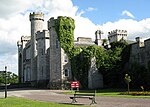Llannefydd F.C.
1998 establishments in WalesArdal Leagues clubsAssociation football clubs established in 1998North Wales Coast Football League clubsSport in Conwy County Borough ... and 3 more
Vale of Clwyd and Conwy Football League clubsWelsh Alliance League clubsWelsh football club stubs
CPD Llannefydd FC (Welsh: Clwb Pêl Droed Llannefydd) is a Welsh football team based in Llannefydd, Conwy County Borough. The team currently play in the Ardal NW, which is at the third tier of the Welsh football league system.
Excerpt from the Wikipedia article Llannefydd F.C. (License: CC BY-SA 3.0, Authors).Llannefydd F.C.
Ffynnon Nefydd,
Geographical coordinates (GPS) Address Nearby Places Show on map
Geographical coordinates (GPS)
| Latitude | Longitude |
|---|---|
| N 53.224416666667 ° | E -3.5315555555556 ° |
Address
Ffynnon Nefydd
LL16 5EA , Llannefydd
Wales, United Kingdom
Open on Google Maps









